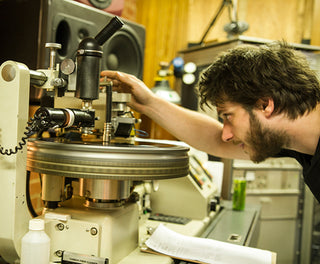Every single day, we all interact with different items without a second thought as to how they work. This is probably for the best in most cases; I feel my days would be wasted in some kind of teenage stoner-like wonderment trying to figure out how the first person to screw two knives together and call them scissors had the insight. Becoming hyper-aware of the engineering that goes into this world around us is much bigger than a single article (Side note: What the hell is “the Internet,” where is all of this writing being stored? Why can’t I see emails flying through the air, etc.). But I occasionally experience insight into things that I have never imagined the process behind. This story is dedicated to one such experience.


Music has been a huge part of my life as long as I can remember. I don’t come from a musical family at all, but we always had music in the house of all kinds. My parents’ mixed record collection, ’50s and ’60s compilation cassettes, movie soundtracks. Grease and Dirty Dancing soundtracks were a staple of my earliest memories. In the early ’90s, my dad went all out to keep up with these modern times and bought a 5 disc CD changer stereo system as a surprise Xmas gift to the family. In mid-December he asked at the dinner table, “What do you boys want for Christmas?” I had been snooping around the day previous and found his Hi-Fi surprise, and wanting him to be super excited about how good he had done (my mum was usually the present buyer), me at age 7 replied, “A 5 disc CD changer!” His face suggested he wanted a less specific answer.
“THE METHOD ITSELF EVOLVES AS THE SKILL AND KNOWLEDGE GROWS.”
The one thing about all of this music that I never considered was: How did it get there? I understood the playing part of it. I even took up drums and played Black Sabbath covers at age 12 as per the vinyl record from my parents collection (how did that get in there Mum?). But how does recorded music get onto that record/cassette/CD? It was a question I never asked. Time has shown us that CDs and cassettes were eventually responsible for squeezing Vinyl out of the market, but have since made themselves redundant as a format with iTunes, streaming, and the like being the choice of the masses. The dark horse in the form of vinyl, though beaten and downtrodden, never actually died though. It went to ground, but was always kept alive by the diehards – and has been on the rise for the past decade or so. Here in Australia, most local acts sourced it to Europe and the USA in recent times, but I knew there was an option here, I just wasn’t sure where.
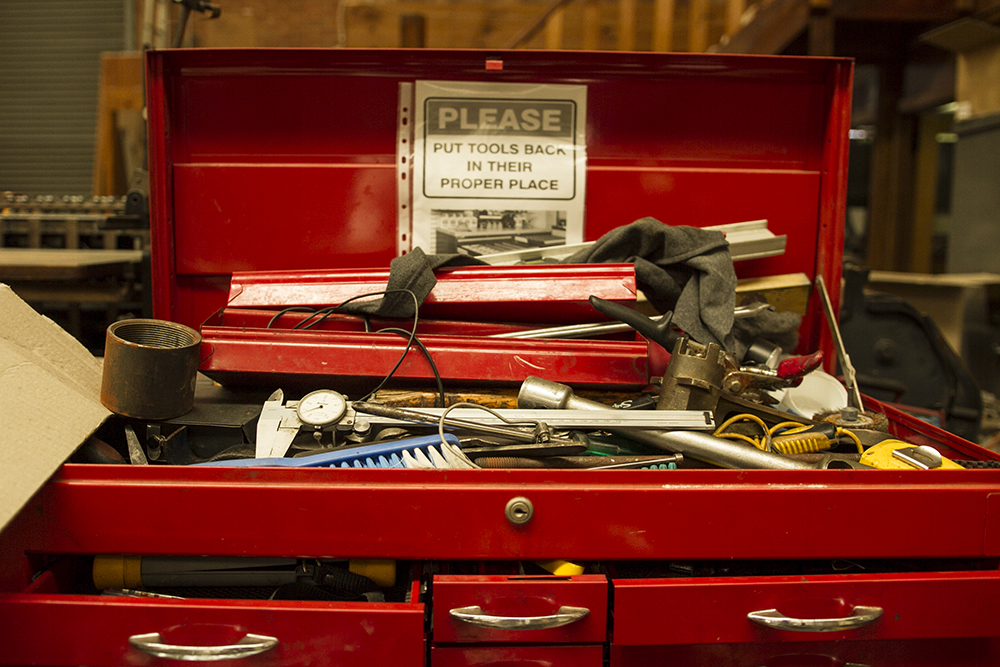
It sprung back into my consciousness when one of my oldest friends Connor (who I played bad covers with) informed me he was now cutting and pressing records at the re-birthed “Zenith Records,” which had almost imploded under the stresses of its own workload/financial woes/equipment issues/market demand. Instead, Zenith had been scooped up by a few lovers of the craft and was undergoing loads of changes to get it back, providing quality locally-produced vinyl pressings. I had to go and see him, meet the owner, and see this magical world where the crackle and hiss I recall from first putting on my parents’ copy of Neil Young’s Harvest was now being birthed to local contemporary music – including bands that I work with regularly. Zenith is the ONLY Australian pressing plant left. In the heyday of the ’60s to the ’80s, there were numerous and they were all cranking full time, but with the fall of the industry, one by one they closed, with a majority of the equipment simply being packed up and sold off as scrap metal to make way for CD production.
I met with one of the new owners of Zenith, Paul Rigby. He spoke to me about what Zenith had been in the past, how it had changed, and how he came to be involved. He was a warm and excited kind of guy; realistic but noticeably positive for someone who had taken on a massive operation which is so inherently mechanical that breakdowns of equipment and technical issues are part of the everyday process. He, like all the guys that work there, has a passion for the details of sound and how it is relayed. There is a tell in the way he leans in towards a speaker as we listen to a Motown-sounding test press in the mastering room, or paces back and forth as the low end bass rumbles through the speakers of a seminal ’90s Australian rock band Something for Kate repress. It’s the kind of passion that I have seen in different industries, be it food, entertainment, art, fashion – and now vinyl. It’s all a process and everything can always be improved upon – the method itself evolves as the skill and knowledge grows. Without the challenge of self-improvement, where do any of us get the motivation the get out of bed in the morning?
Side note: This place feels like a mix between the Breaking Bad meth lab and something out of Mad Max, but the end product are these precise and fragile pieces of archival work. It’s a very strange contrast.
I did notice that the building’s signage was somewhat underwhelming. Paul and I discussed this also. New signage and painting their building is now something else on my to-do list, more on that in the future.

CALLUM: How did this incarnation of Zenith come to be?
PAUL RIGBY: My business partner Chris, the original owner and still part owner had retired and needed something to get back into. He cut his teeth in the late ’60s in the vinyl record game at the long since shutdown Astor plant here in Australia. He bought the Zenith plant from the Obese Records guys in about 2005 – they had run it since about 2000. Chris had a few guys running it, went over to Italy to pick up a couple more machines and got sidetracked, ended up running a pressing plant in Italy, then one in the UK. Meanwhile the guys back in Australia were pretty under-resourced – most of them walked and he ended up having one person out there running the plant in its old location under an abandoned flour mill in the suburb of “Sunshine” west of Melbourne.
“I HAD SO MUCH INVESTED IN THIS THAT FAILURE WAS NEVER AN OPTION.”
The lack of staff and resources meant that the Zenith brand began to get a bad reputation with some clients, with wait times blowing out. I got involved late 2012. The owner Chris who I was friends with called me from overseas and said, “I can’t do it anymore. I’m too busy. I’m running a plant over here. I’ve gotta sell the site Zenith is currently at. I’m gonna mothball it, but I know you want to do it.” We eventually agreed on a plan, whereby I would take on the task on the condition I could get it setup and working somewhere. I was pretty much a basket case. He said to me, “I still want to be involved, I will share my knowledge and won’t let you fail.” So based on his assurances and our past relationship having known him for a long time, I rolled the dice and went in. We spent 5 or 6 months packing up the plant and moving everything and getting it up to the point where it was actually running. A long hard task, but with a little bit of backup from him, a huge amount of tinkering and learning on the fly. I had so much invested in this that failure was never an option. We had to get rolling and had to get good product out the door and begin the build that reputation again. I come from a CD manufacturing background, but it’s a different game, and we are working with a mix of machinery old and new. We are now up and running and we have added to the rig with auto machines and plating stuff. We are growing and getting stronger as we go.

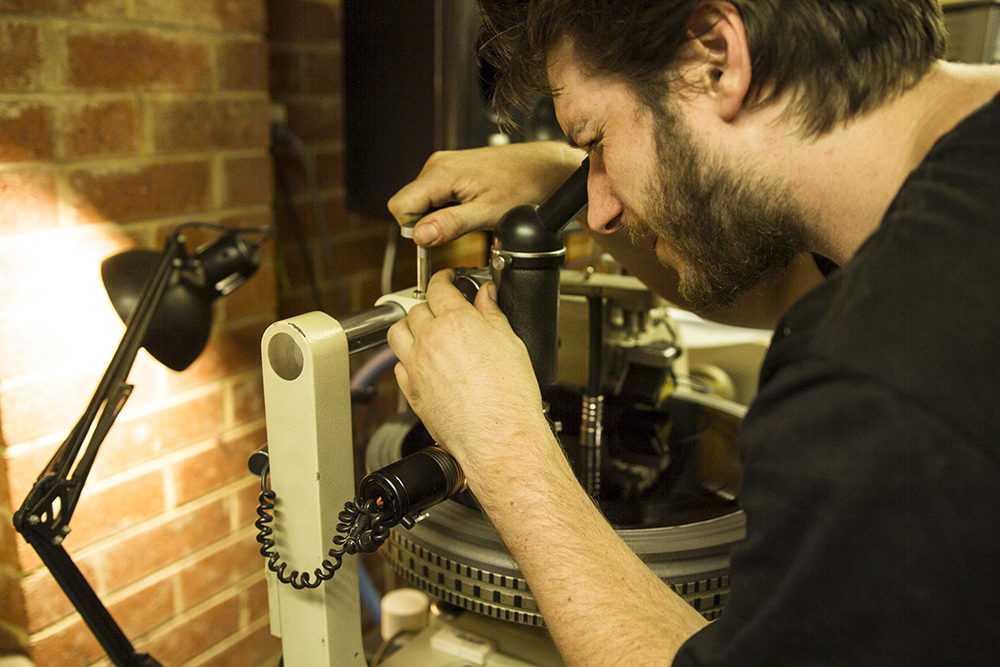
Connor sets up cutting for an original master that will go on to be treated and become the positive plates for the pressing machine. He is essentially reading squiggly lines through a microscope to make sure that it will sound good. Insane.







The machinery setup is a mixed bag. To the untrained eye it seems like organised chaos. Is this equipment responsible for pressing a lot of classic Australian music?
This equipment at the bare bones level is what was known as the Corduroy Press. Those guys actually deserve the credit. They picked up the machinery when it was being hauled off to be sold as scrap metal – literally being sold off to be melted down. They got together and bought it as a group of people in the early to mid ’90s. A very small community effort of vinyl diehards who picked it up and in a ramshackle arrangement got it back up and running till they sold it around 2000 to the Obese Records guys when it became Zenith. Those original Corduroy guys are the reason we even have some of the gear today that can still press this stuff.
The equipment has pressed anything from rock/metal/hip hop/spoken word/ jazz/opera over many years of production and different owners. What kind of things are you pressing now as a vinyl plant in 2014?
We actually are doing a big mix of major label stuff, because for them, the vinyl market is something that they have now realised they can’t deny anymore. We have worked hard at getting our quality to be as good as anywhere in the world, but we have the same problems as any plant around the world. One machine goes down – we don’t have 5 others running [so] we have to keep on top of demand. We have major releases, stuff for Warner, Inertia, Universal, and Sony, but alongside that, a lot of punk and metal for local true “Indie” labels, and small bands that really would never have had the capacity to do vinyl without a local option. We don’t have a “bread and butter” as such; every week is different.
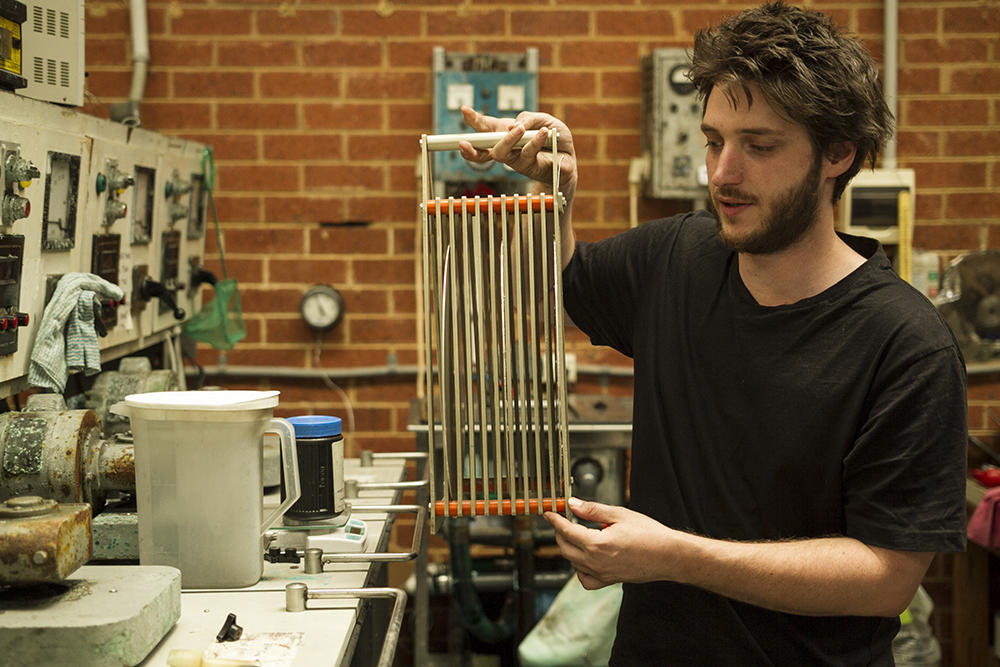


The silver plate is the raised mirror of the groove from the original, meaning when placed in the press it directly duplicates the grooves into the molten vinyl

You are the only place in Australia that presses vinyl, so it’s a marketshare, but it’s also a responsibility to provide a service that stands up globally. How has it been received by the marketplace?
It has gone hand in hand as our quality has improved, and we have a greater understanding for when shit breaks down. The demand has also increased and word is spreading. It’s been totally organic, but we are always working to improve that somewhat “mixed” reputation of the past Zenith. I deal with clients who have always pressed here since it began and never had a problem, but in my previous work in similar industry, I had worked on jobs to try and salvage a release that had fallen between the cracks at Zenith back in the day. I’m not in denial about the past issues. Our focus now is on providing our clients with reliable service and quality product and that is something tangible that they can see, feel, smell, and most of all hear. The proof is in the final outcome. In the past as the Australian dollar got stronger most people had taken this work overseas, and the reality is our production costs and running costs mean that it is more expensive to produce here. But on the other side of that, we can turn them around quicker, we don’t have freight, we don’t have customs issues and it is Australian music that is being made in Australia – and pressed here. There is a part of the market that places great value on that local idea. It’s all dependent on your marketplace. If your band is massive in Europe and not so much here, they usually have a relationship with a plant over there and it makes sense financially and logistically, but as Australians, we love music, especially our local acts, and that’s where we fall in.
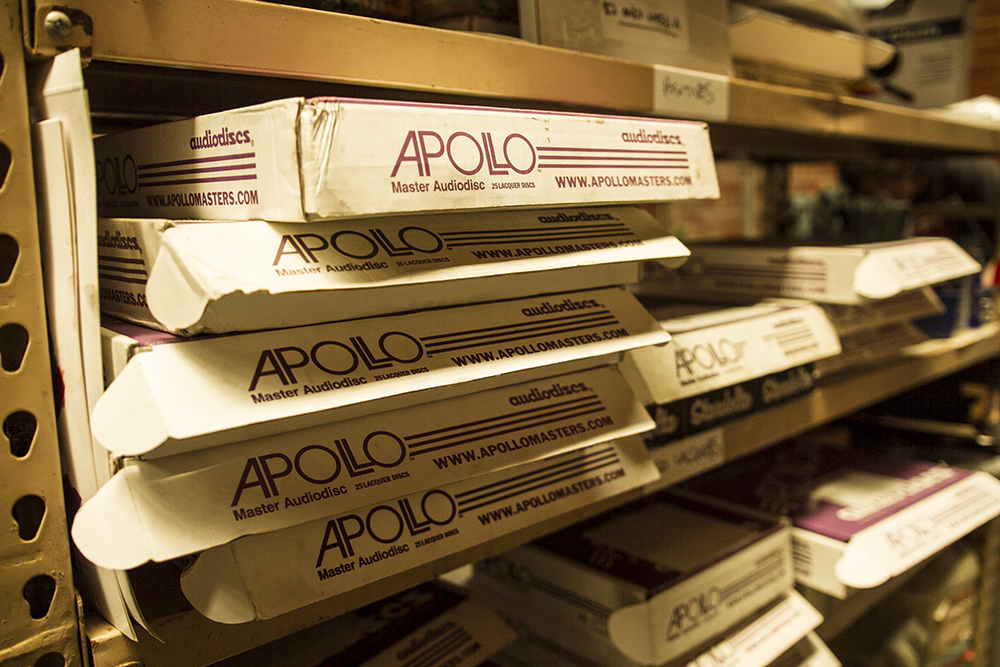
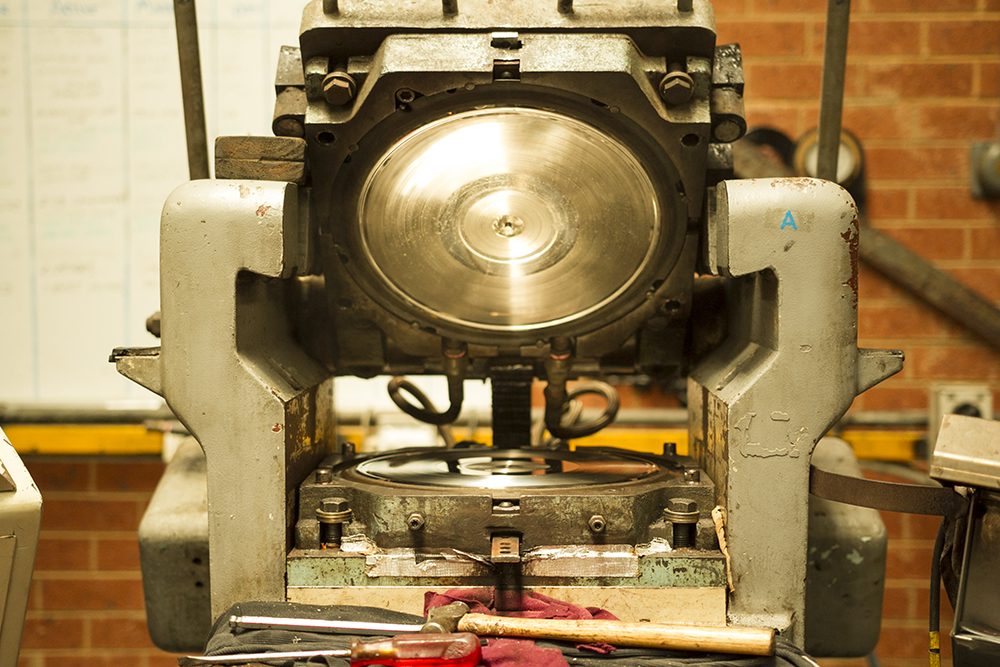
“VINYL JUST DEFIES EVERYTHING.”


The molten plastic which records are pressed from is a 50/50 mix of whats called “Virgin” which is the round pellets above, and the grinds below which is all of the offcuts from the lumpy edges, excess, misprinted and warped vinyls that are fed through what is essentially a woodchipper to then be reused.

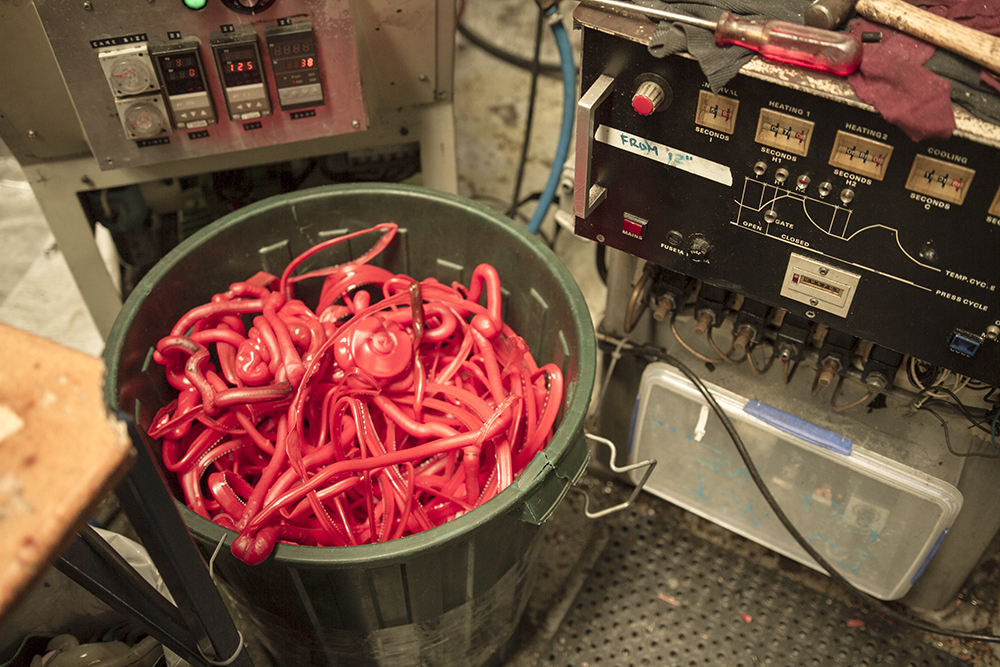
What’s your take on how this current setup works?
The fact is this space is probably slightly too small, eventually we will have our full offset printing gear up and running, which we currently outsource. In the meantime, excess machinery and equipment has just become stuff we put other stuff on top of. The machines are always breaking down just by virtue of both the age and type of work they do, so we have to clear space around them for running repairs, as well as the fact that it is a dirty, messy, wet, sticky process with offcuts and excess, etc. as well as the mechanical elements of grease, steam, oil. It’s never going to be a clean setup, but it’s all about the end product and whatever it takes to get that record off the press. Essentially the floor plan is simply whatever it takes to get the best workflow, as well as dealing with ongoing repairs. You are always going to end up with crap on the floor and the surrounds. I’d say one of the best pieces of equipment we have is the wet/dry vacuum cleaner [laughs].



Would you describe yourself as a vinyl nerd?
I guess so. Not totally, not to the extent of some people. But for sure vinyl is where all my money went as a teenager, buying records was and still is a favorite pastime. When CDs came in and I started buying CDs, I ended up involved in the CD industry, doing production, etc. But personally for me, when there was a record I wanted to own, I always much preferred to have it on vinyl. Also early on when CDs were coming in there were endless bargains to be had with vinyl ’cause everyone was cashing in their vinyl collections.
Did you ever picture owning a vinyl pressing plant?
No, definitely not. I sort of fell into that CD world by accident and was kind of always waiting for something better to come along, then this place sort of fell into my lap, but also sort of didn’t. I mean, it did, but with a lot of hard work, a lot of dough on the table. It’s a massive amount of work and takes a whole team of people.

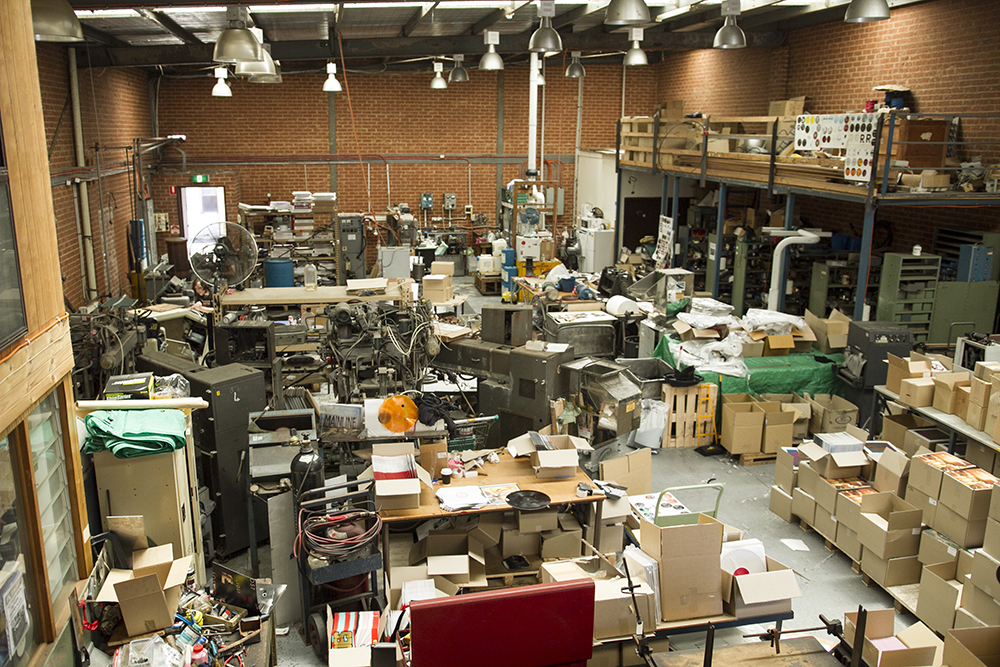
So then, what is the future of vinyl?
It’s impossible to say for sure. I could guess and say another 5 years of the current resurgence its having? But will it never disappear totally – I wouldn’t think so. I think there is a whole new generation that is switched onto it. Plus people are inherently nostalgic, so vinyl just defies everything, which is one of the other reasons I love it as well. It doesn’t follow any pre-planned strategy that’s been imposed on the music listening public by the major labels who say, “Okay now you listen to CDs. It’s the future – with laser technology!” Which they did do, and it worked for quite a while but they sufficiently devalued and eventually the public began to turn around and say, “We want the classic format.”
It’s a much more archival format. You cant deny 100 years of putting recorded music on a format that really set the standard and established how the public received music. And it’s something obtainable by the masses, against the CD format, which I feel outlived its usefulness as well as the fact that the price point when it came out [which was] anywhere between $20 and $30 for this “digital technology” has never really come down. The reward isn’t there, whereas a vinyl is a much more tactile experience. The difference between the manufacturing cost and its retail cost is where the major labels really hate it, though. With a CD they could make 1000% margin on a sale… The window of profit is much smaller [and] our manufacturing cost to profit margins for their wholesale order are also just as small. Vinyl pressing is an entire industry that is a labor of love, really.

::

